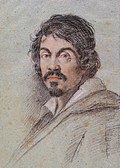Archivo:Caravaggio.emmaus.750pix.jpg

Este archivo es de Wikimedia Commons y puede usarse en otros proyectos. La descripción en su página de descripción del archivo se muestra debajo.

|
Este archivo ha sido reemplazado por File:1602-3 Caravaggio,Supper at Emmaus National Gallery, London.jpg. Se recomienda usar el otro archivo. Nota: este archivo no será borrado a menos que sea explícitamente propuesto para ser borrado.
|

|
Resumen
| Caravaggio: Los discípulos de Emaús (Caravaggio, Londres)
|
||||||||||||||||||||||||||||
|---|---|---|---|---|---|---|---|---|---|---|---|---|---|---|---|---|---|---|---|---|---|---|---|---|---|---|---|---|
| Artista |
artist QS:P170,Q42207 |
|||||||||||||||||||||||||||
| Título | ||||||||||||||||||||||||||||
| Object type |
pintura |
|||||||||||||||||||||||||||
| Género |
arte sacro |
|||||||||||||||||||||||||||
| Descripción | ||||||||||||||||||||||||||||
| Personas retratadas |
Jesús de Nazaret |
|||||||||||||||||||||||||||
| Fecha |
entre 1601 y 1602 date QS:P571,+1601-00-00T00:00:00Z/8,P1319,+1601-00-00T00:00:00Z/9,P1326,+1602-00-00T00:00:00Z/9 |
|||||||||||||||||||||||||||
| Técnica | pintura | |||||||||||||||||||||||||||
| Dimensiones |
altura: 55 in (139,7 cm); ancho: 77 in (195,5 cm) dimensions QS:P2048,55U218593 dimensions QS:P2049,77U218593 |
|||||||||||||||||||||||||||
| Colección |
institution QS:P195,Q180788 |
|||||||||||||||||||||||||||
| Número de inventario |
NG172 (National Gallery de Londres) |
|||||||||||||||||||||||||||
| Historial de la pieza |
commissioned by Ciriaco Mattei in 1601-02 |
|||||||||||||||||||||||||||
| Notas | The focal point of this picture is a beardless Jesus. Picture prepared for Wikipedia by Adrian Pingstone in April 2003. | |||||||||||||||||||||||||||
| Referencias |
|
|||||||||||||||||||||||||||
| Control de autoridades | ||||||||||||||||||||||||||||
| Fuente/fotógrafo | http://www.kfki.hu/~arthp/html (Web Gallery of Art). http://en.wikipedia.org/wiki/Image:Caravaggio.emmaus.750pix.jpg | |||||||||||||||||||||||||||
Licencia
|
Esta es una reproducción fotográfica fiel de una obra de arte bidimensional de dominio público. La obra de arte misma se halla en el dominio público por el motivo siguiente:
La postura oficial de la Fundación Wikimedia considera que «las reproducciones fieles de obras de arte bidimensionales de dominio público forman parte del dominio público».
Esta reproducción fotográfica, por ende, también se considera de dominio público dentro de los Estados Unidos. Es posible que otras jurisdicciones restrinjan la reutilización de este contenido; consúltese Reutilización de fotografías PD-Art (en inglés) para más detalles. | |||||
Leyendas
Elementos representados en este archivo
representa a
image/jpeg
b4468bc6eeae1c2146963c173479f8273f5508da
177 375 byte
850 píxel
1203 píxel
Historial del archivo
Haz clic sobre una fecha/hora para ver el archivo a esa fecha.
| Fecha y hora | Miniatura | Dimensiones | Usuario | Comentario | |
|---|---|---|---|---|---|
| actual | 09:21 14 ago 2007 |  | 1203 × 850 (173 KB) | Argento | same source but bigger |
Usos del archivo
La siguiente página enlaza a este archivo:
Metadatos
| Comentario de archivo JPEG | CARAVAGGIO
(b. 1571, Caravaggio, d. 1610, Porto Ercole) Supper at Emmaus 1601-02 Oil on canvas, 139 x 195 cm National Gallery, London The gospel according to St Luke (24:13-32) tells of the meeting of two disciples with the resurrected Christ. It is only during the meal that his companions recognize him in the way he blesses and breaks the bread. But with that, the vision of Christ vanishes. In the gospel according to St Mark (16:12) he is said to have appeared to them "in an other form" which is why Caravaggio did not paint him with a beard at the age of his crucifixion, but as a youth. The host seems interested but somewhat confused at the surprise and emotion shown by the disciples. The light falling sharply from the top left to illuminate the scene has all the suddenness of the moment of recognition. It captures the climax of the story, the moment at which seeing becomes recognizing. In other words, the lighting in the painting is not merely illumination, but also an allegory. It models the objects, makes them visible to the eye and is at the same time a spiritual portrayal of the revelation, the vision, that will be gone in an instant. Caravaggio has offset the transience of this fleeting moment in the tranquillity of his still life on the table. On the surfaces of the glasses, crockery, bread and fruit, poultry and vine leaves, he unfurls all the sensual magic of textural portrayal in a manner hitherto unprecedented in Italian painting. The realism with which Caravaggio treated even religious subjects - apostles who look like labourers, the plump and slightly feminine figure of Christ - met with the vehement disapproval of the clergy.
Author: CARAVAGGIO Title: Supper at Emmaus Time-line: 1551-1600 School: Italian Form: painting Type: religious |
|---|


